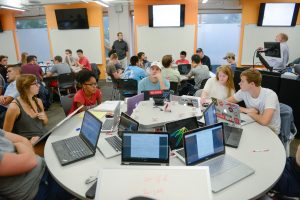Class Culture and Grading
Open sourcing AI frameworks, democratization of AI, and the collaborative culture in the AI community can be partially credited for the AI revolution. Researchers from giant AI companies are publishing their research results. Uploading preprints to arXiv, an open access repository, has became a norm in the AI field. Researchers and developers are hosting their source code on Github so that everyone can pull the source code and reuse. Google, Facebook and other large companies that tend to be very protective of their technologies, are open sourcing their machine learning frameworks for everyone! Simply put, modern AI is built upon sharing and cooperation, open access, and open source frameworks.
In PY-599, Applied Artificial Intelligence, we embrace and adopt this vision and culture, and bring it into the class. Collaboration is not only allowed but encouraged. Our classroom, COX 105, is an interactive classroom, where students sit at round tables. The class arrangement is designed in order to induce and create collaboration. In real world no one develops a machine learning solution from scratch and in solitary! Machine learning practitioners take advantage of free, open source frameworks that simplify the development process, reuse bits and pieces of other people’s codes, check Stack Overflow to find solutions to their problems, etc. In PY-599, Applied Artificial Intelligence, we follow this process.
Moodle forums are set up to create an online forum for discussion and collaboration. Students are encouraged to post questions about homework, projects, or any other material related to the course, or answer the questions posted by the other students. Active students who engage in the forum discussions and provide help to classmates will receive extra points that will count towards their final grade.

Of course there are common-sense limitations to the amount of collaboration or use of available resources. For example, copying and pasting someone else’s work and submitting it as yours is not called collaboration!
No group submission unless it is explicitly allowed by the instructor for that assignment.
The instructor will be providing guidelines for each assignment to determine the type and the amount of allowed collaboration or use of available resources. But these guidelines will tend to be very relaxed.
Grading:
Final grade will be determined as a weighted average of categories below:
| Attendance | 10% |
| Homework | 30% |
| Exams | 30% (15% each) |
| Final Project | 30% |
The grading scale for the course is as follows:
| [95, 100] | A+ |
| [90, 95) | A |
| [85, 90) | A- |
| [80, 85) | B+ |
| [75, 80) | B |
| [70, 75) | B- |
| [60, 70) | C |
| [50, 60) | D |
| [0, 50) | F |
In order to cultivate collaboration in the class, grades are absolute and will not be curved. Therefore there is no competition between students to fall within different parts of curve distribution.
